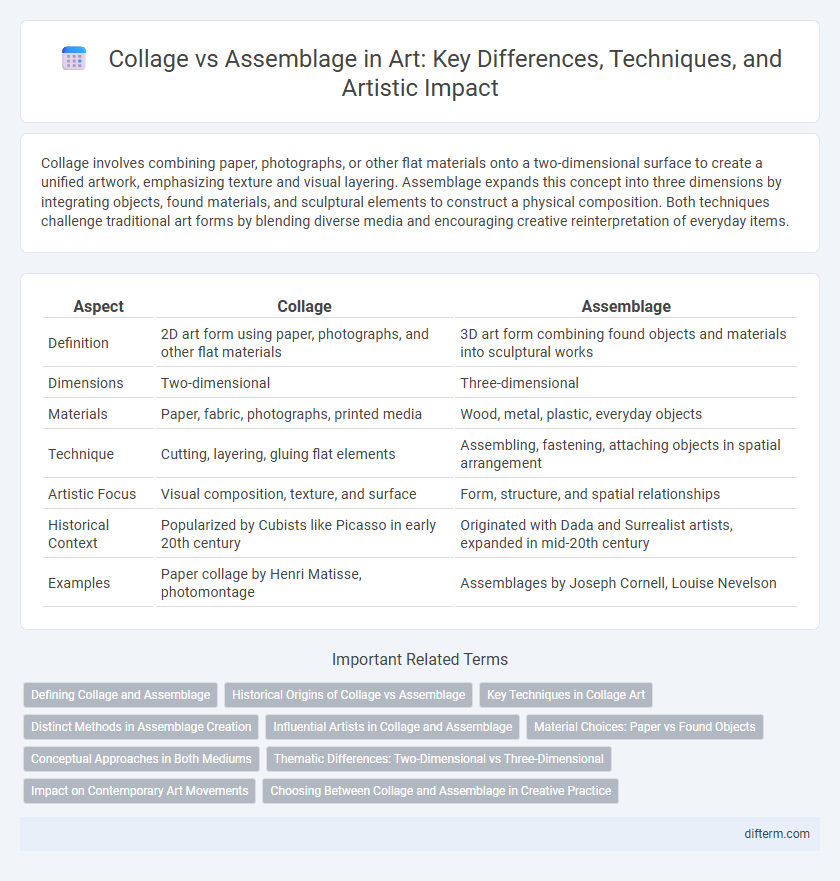Collage involves combining paper, photographs, or other flat materials onto a two-dimensional surface to create a unified artwork, emphasizing texture and visual layering. Assemblage expands this concept into three dimensions by integrating objects, found materials, and sculptural elements to construct a physical composition. Both techniques challenge traditional art forms by blending diverse media and encouraging creative reinterpretation of everyday items.
Table of Comparison
| Aspect | Collage | Assemblage |
|---|---|---|
| Definition | 2D art form using paper, photographs, and other flat materials | 3D art form combining found objects and materials into sculptural works |
| Dimensions | Two-dimensional | Three-dimensional |
| Materials | Paper, fabric, photographs, printed media | Wood, metal, plastic, everyday objects |
| Technique | Cutting, layering, gluing flat elements | Assembling, fastening, attaching objects in spatial arrangement |
| Artistic Focus | Visual composition, texture, and surface | Form, structure, and spatial relationships |
| Historical Context | Popularized by Cubists like Picasso in early 20th century | Originated with Dada and Surrealist artists, expanded in mid-20th century |
| Examples | Paper collage by Henri Matisse, photomontage | Assemblages by Joseph Cornell, Louise Nevelson |
Defining Collage and Assemblage
Collage is an art technique that involves adhering various materials such as paper, photographs, and fabric onto a flat surface to create a unified composition. Assemblage extends this concept into three dimensions by combining found objects, often everyday items or discarded materials, into sculptural forms. Both methods emphasize juxtaposition and texture but differ in their use of space and dimensionality.
Historical Origins of Collage vs Assemblage
Collage originated in the early 20th century through Cubist artists like Pablo Picasso and Georges Braque, who incorporated newspaper clippings and other materials into their paintings to challenge traditional art forms. Assemblage emerged later in the 1950s, influenced by the Dada movement and artists such as Marcel Duchamp, focusing on three-dimensional compositions using found objects. Both techniques revolutionized art by integrating everyday materials, but collage emphasizes two-dimensional layering while assemblage prioritizes sculptural, spatial arrangements.
Key Techniques in Collage Art
Key techniques in collage art include layering various materials such as paper, fabric, and found objects to create textured compositions. Artists employ cutting, tearing, and adhering these elements onto a surface to explore contrast, harmony, and narrative. Strategic placement and integration of images and texts enhance the visual and thematic depth of the artwork.
Distinct Methods in Assemblage Creation
Assemblage art involves creating three-dimensional compositions by assembling found objects, offering a tactile and spatial depth that differs from collage's primarily two-dimensional layering of paper and flat materials. Artists use welding, gluing, or nailing techniques to combine disparate materials such as wood, metal, and fabric in assemblage, emphasizing texture and form. This method results in dynamic sculptures that invite viewers to explore multiple perspectives, contrasting with the visual layering and juxtaposition characteristic of collage.
Influential Artists in Collage and Assemblage
Pioneering artists like Pablo Picasso and Georges Braque revolutionized collage by integrating paper fragments into Cubist compositions, setting a foundation for modern art. Assemblage was notably advanced by Joseph Cornell, whose intricate box constructions combined found objects to create poetic narratives. Both mediums saw influential contributions from Robert Rauschenberg, whose "Combines" blurred boundaries between painting and sculpture, merging collage and assemblage techniques.
Material Choices: Paper vs Found Objects
Collage primarily utilizes paper materials such as magazines, photographs, and textured paper, allowing artists to layer and manipulate flat surfaces to create intricate visual compositions. Assemblage incorporates found objects like wood, metal, fabric, and everyday items, emphasizing three-dimensionality and tactile engagement. The choice between paper and found objects significantly influences the artwork's texture, depth, and conceptual impact within each medium.
Conceptual Approaches in Both Mediums
Collage and assemblage both emphasize conceptual exploration by combining disparate elements to create new meanings and challenge traditional perspectives. Collage involves layering two-dimensional materials like paper and photographs to reinterpret imagery and narrative, while assemblage incorporates three-dimensional objects, inviting tactile engagement and spatial awareness. Both mediums use juxtaposition and fragmentation to provoke reflection on cultural, historical, and personal contexts through their unique material languages.
Thematic Differences: Two-Dimensional vs Three-Dimensional
Collage emphasizes two-dimensionality by combining paper, photographs, and other flat materials to create layered visual narratives on a single plane. Assemblage involves three-dimensional construction, integrating found objects and sculptural elements that extend into space to enhance tactile interaction. Thematic exploration in collage often centers on surface and image juxtaposition, whereas assemblage explores volume, depth, and materiality.
Impact on Contemporary Art Movements
Collage revolutionized contemporary art by enabling artists to juxtapose diverse materials and images, fostering experimentation in movements such as Cubism and Dada. Assemblage extended this innovation by incorporating three-dimensional objects, influencing Surrealism and later installation art. Both techniques challenged traditional aesthetics, paving the way for postmodern explorations of identity and cultural critique.
Choosing Between Collage and Assemblage in Creative Practice
Choosing between collage and assemblage hinges on the desired dimensionality and material interaction in creative practice. Collage involves adhering flat materials such as paper or photographs onto a surface, emphasizing two-dimensional composition and visual layering. Assemblage incorporates three-dimensional objects, creating tactile, sculptural works that engage spatial relationships and material contrasts.
collage vs assemblage Infographic

 difterm.com
difterm.com